Environmental initiatives continued to be our priority throughout the year 2005/06. In the past year, we were able to decrease our water and energy consumption and material usage and reduce domestic waste. Air and noise nuisances also decreased significantly with the use of better construction and operational equipment and practices. The implementation of our green initiatives, such as usage of sustainable materials, trial studies on environmentally friendly materials, monitoring of waste recovery rates and installation of water saving appliances, etc., all contributed to our improved environmental performance.
One example of the new initiatives that we implemented in the past year was the 'Green Delight in Estates' (GDE) programme in collaboration with local green groups in mid 2005. This programme aimed at increasing tenant awareness on environmental protection and waste recovery, and encouraging tenants to participate in environmental activities through community cohesion activities. These included a campaign for cleaning up our estates, training and awareness programmes and recruitment of Green Ambassadors. It is anticipated that more volunteer groups will be organized to lead in environmental efforts for each estate; and that, through such a sustainable programme, a long-term environmental commitment and increased community participation will be maintained. Recent surveys in different estates undertaken by the Housing Authority showed that more than 70% of the participated tenants in the GDE programme ranked themselves more aware of environmental issues.
Of the ongoing initiatives, we continued to conduct micro-climate studies in the design process to ensure that we maximize or address environmental factors, such as local wind patterns, natural ventilation of buildings, pollutant dispersion, day-lighting standards, thermal comfort, energy-efficiency and traffic noise in all our new developments. In this way we adhere to our vision of building sustainable housing, as well as provide a healthier, more natural environment for our tenants. In 2005/06, master layout plans and scheme designs resulting from this process were approved for four new developments - Sha Tin Pass Road, Tung Tau Cottage Area West, ex-Chai Wan Estate and Choi Wan Road Sites 2 and 3B.
In the past year, we have also attained recognition for our sustainable building design and construction under the HK-BEAM, the Hong Kong Building Environmental Assessment Method. This programme has earned us a top-level platinum rating (provisional) for the Upper Ngau Tau Kok Phases 2 and 3.
Enhancing the comfort and attractiveness of estates for our residents through landscaping and planting of greenery has long been one of our priorities during construction, management and maintenance activities for our estates.
In 2005/06, our Landscape Architects and Horticulture Team have continued their efforts to improve the living environment on our estates. About 4,100 trees, 527,400 shrubs and 92,000 annuals were planted in the year.
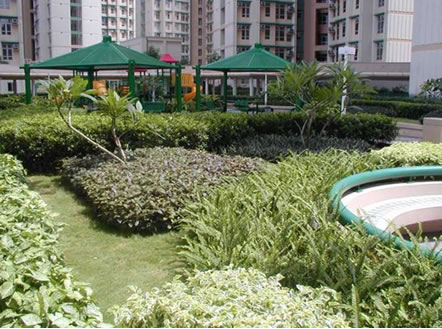
| Targets | Our Performance | |
| • | Provide green treatment to newly formed slopes. | All of the newly formed slopes in 2005/06 with a total area of 1,900 m2 were treated by hydro-seeding, planting of creepers, trees, etc. |
| • | Upgrade the existing landscape facilities in selected PRH estates. | 110,450 m2 of landscape improvement were completed in 18 estates. |
| • | Promote a green environment at PRH estates with Estate Management Advisory Committee (EMAC) support. | 5,800 m2 of greening improvement were carried out in 12 estates. |
| • | Improve slope appearance in existing PRH estates. | Green treatment was applied to ten slopes in six estates. |
| • | Set up theme gardens to enhance awareness of greening in PRH estates. | Rhododendron Gardens were set up at Lei Muk Shue Estate and Nam Shan Estate. |
| • | Maintain planting and greening standards in new PRH estates. | Greening and planting continued to be a key consideration throughout the design and building process for new PRH estates. |
| We have continued to make best use of the natural characteristics of the estates by preserving existing greenery and maximizing and expanding landscaped areas. For instance, in the past year our work has included setting up roof-top gardens on some of our lower housing blocks. |
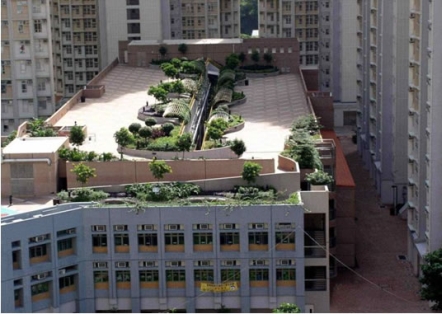
Our ongoing programme to provide special theme gardens in selected estates also continued in the past year with colourful Rhododendron Gardens completed at both Lei Muk Shue and Nam Shan Estates.
As part of the GDE programme, residents in selected estates were able to enjoy some closer encounters with nature through visits to tree trails and butterfly gardens on our estates.
Every year we organize tree planting days at selected estates to raise awareness of our extensive greening efforts and achievements. This year we invited 300 of our staff and residents to join us in Tree Planting Days.
We held the Housing Authority Flower Show at Lok Fu Estate in December 2005 and January 2006 for the enjoyment of residents and the public.
| Targets | Our Performance | |
| • | Reduce water wastage in large diameter bore piling (LDBP) works. | All new contracts for LDBP works include mandatory installation of waste water recycling facilities. |
| • | Reduce flushing water consumption. | Completion of pilot trial in Housing Authority Headquarters (HAHQs) and Shek Lei Ph 10 identified as the estate to undergo trial for dual flush WC cisterns. |
| • | Install mandatory water recycling facilities in all new building, piling and civil engineering contracts. | All new contracts include mandatory installation of waste water recycling facilities. |
| • | Reduce potable water consumption under landlord installations in PRH estates. | Use of self-stopping water tap and reduction of pipe bursting and leakage through replumbing led to a 13% decrease in water consumption against 2004/05. |
We are fully committed to ensure the plumbing systems on our estates deliver clean and safe potable water to households. To give our residents peace of mind on this issue, in 2003 we were committed that all housing blocks in our estates would join the Fresh Water Plumbing Quality Maintenance Recognition Scheme. This scheme was launched by the Water Supplies Department (WSD) in 2002 and involves regular monitoring of water supplies in buildings. In line with our commitments, we are progressing as planned with entering our public rental housing blocks into the scheme. As of 31 March 2006, 801 or 76% of our public rental housing blocks have been certified. Among these, 438 blocks were certified in 2005/06. We expect all the remaining 249 of our public rental housing blocks will be issued certificates in 2006/07.
To safeguard the quality of potable water reaching our residents, we have continued our ongoing programme of replacing the original galvanized steel pipes with copper or uPVC-lined steel pipes in entire housing blocks. This is a proactive solution to address discolouration of water that can occur when galvanized steel pipes deteriorate with age. As at 31 March 2006, we have finished replumbing a total of 742 PRH blocks including 30 blocks completed in 2005/06.
In the past year, we have continued measures to save water and prevent water wastage in our construction works. Following consultations with the Hong Kong Construction Association, for the first time we have made it a mandatory requirement for our contractors to use Water Recycling Systems for all contracts involving Large Diameter Bore Piling Works as well as in all new building, piling and civil engineering contracts. In 2005/06, there was a total of eight construction contracts underway which have all followed this requirement. By doing so, our contractors have helped to save considerable quantities of water.
|
In our estates, we have continued to implement measures to reduce water wastage at outlets under our control. Such measures include the use of water saving self-stopping taps and replumbing works with the aim of stopping water leakage and preventing pipe bursting. In the past year, our records indicate water consumption from our outlets has dropped significantly (13% less compared to 2004/05). |
We have continued to seek ways to reduce water consumption in our premises. In the past year, we extended a trial scheme on the use of dual flush toilets in HAHQs headquarters building with a similar trial in the new Shek Lei Estate, which is under construction. Findings of the study in the HAHQs indicate that their use has been effective at reducing volumes of flushing water. We will review the performance of these facilities under domestic usage in Shek Lei upon population intake with the aim of wider use in our premises.
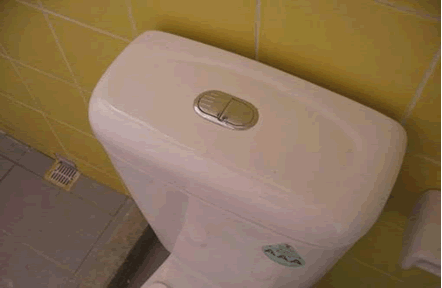
We continued to incorporate measures to effectively control air quality aspects of our operations on our construction sites, estates and offices. In addition, our energy targets are also primarily set to contribute to addressing air quality issues in Hong Kong.
Controlling Fugitive Emissions from our Construction and Demolition Sites
To ensure that fugitive emissions from our construction and demolition (C&D) sites are properly controlled, we continued to implement requirements for contractors working on Housing Authority C&D works to implement all practicable means to avoid or otherwise control dust and exhaust emissions from their works and construction vehicles. Our requirement of hard paved construction also helped to enhance cleanliness and dust control on our construction sites.
| In the past year, we have undertaken an innovative pilot project to further increase the use of precast building elements on projects. Instead of our usual level of 18% (by volume of concrete), our new buildings at the Kwai Chung Flatted Factory project included 60% pre-cast elements. More use of precast, prefabricated building elements, thus reducing various unnecessary construction activities, is expected to lead to lower fugitive emissions from the construction site. |
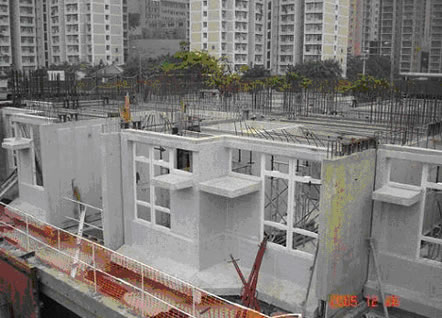
We recognize maintaining good indoor air quality is an integral part of good building management. We introduced the misdeed item under the Marking Scheme for Tenancy Enforcement since 1 January 2006 to prohibit "smoking in lift car of domestic blocks of public housing estates" as an initiative for the benefit of our residents. For the health and comfort of our office staff and visitors, we continued to enforce our smoke-free policy in our headquarters and other office premises.
We continued to pay close attention to the management of refuse collection rooms in our public housing estates. In 2005/2006, we have installed another 44 packaged deodorizers in refuse collection points in the buildings to help control odours and prevent nuisance to our residents and management staff.
Since the ban on the use of certain ozone depleting chemicals, we have gone a long way to completely phasing out their use in recent years. None of our air conditioning units or chillers uses ozone depleting chlorofluorocarbon (CFC). We also do not have halogen gas fire extinguishers. Through our environmental procurement policy, we avoid building materials that include ozone depleting chemicals.
We are fully aware that regional air pollution and climate change issues are high on the local and international agenda. We discuss our progress in reducing our energy consumption and improving energy efficiency in the energy section (see Energy Section). In finding ways to reduce our demand for energy, we are also contributing to efforts for reducing air pollution and greenhouse gas emissions from local power stations.
We also support the Action Blue Sky Campaign of the HKSAR Government launched in July 2006. As a response to this, we have continued to implement measures on the following:
- Operating using international standards: Sustainable design and planning through micro-climate studies and life cycle assessment; installations do not use CFCs and comply with local air regulations; greening activities; implementation of good site practices that decrease dust and air emissions; purchasing materials that are environmentally-friendly and using natural or organic fertilizers/pesticides as much as possible.
- Publishing information on energy use: We have presented our performance in Energy Section.
- Undertaking energy efficient measures. We design our flats in accordance with HKSAR's Building Energy Codes and explore the application of renewable energy.
- Identify and encourage business relevant measures on days when air pollution is high. We promote the practice of encouraging our staff to use public transportation on days when the pollution levels are high.
- Share air quality expertise with others. We share our experience and knowledge of air pollution reduction at the local and international level through conferences and seminars.
As part of our ongoing programme to replace 3,000 rpm water pumps with quieter 1,500 rpm models in our estates, we set ourselves a target for 2005/2006 to replace a further 15 pumps (see Table below). We have made substantial progress on this target with 14 replacements completed as at 31 March 2006, with another two in hand. Since this programme began in 2000/2001, we have replaced a total of 184 such pumps which have improved the living environment of residents on our estates.
| Target | Our Performance | |
| • | Reduce noise nuisance from water pumps in PRH estates. | Replacement of 14 pumps. We are still undertaking the replacement of two more pumps in the Model Housing Estate. |
In 2005/2006, we received eight noise complaints. In the past year, no noise abatement notice was received from EPD, a decrease from the previous year.
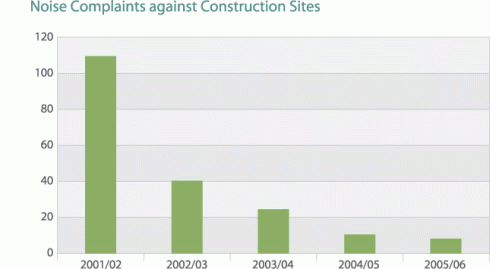
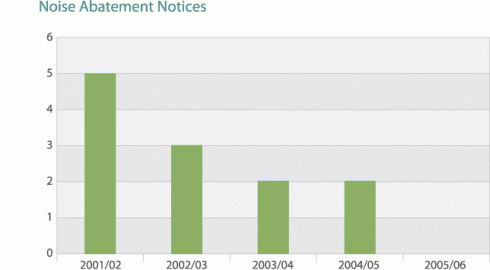
One of the major benefits of the use of prefabricated and precast building elements is cutting down noise from construction activities. In the past year, we made substantial advances in the use of pre-cast and prefabricated building elements in our new projects. With less in situ concreting works on site, this contributed to a sizable reduction in noise generated on-site.
The use of hydraulic concrete crushers, which generates less noise than percussive crushers, in construction or demolition work is also being undertaken by our contractors. We have developed guidelines on this use for noise-sensitive construction sites.
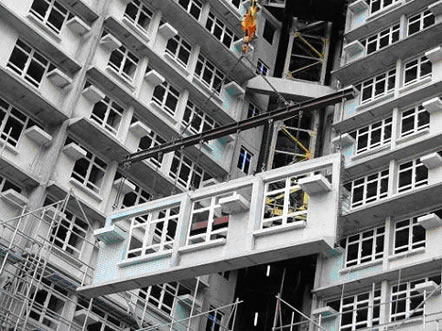
With increasing energy demand and the accompanying environmental impacts associated with its use, we are consciously working towards reducing energy use in our headquarters/offices and in public areas of our estates and enhancing energy efficiency in our new projects.
| Targets | Our Performance | |
| • | Reduce electricity consumption of landlord services (ie services provided to areas managed by the Housing Authority) installation in new domestic blocks. | Adopted energy codes and obtained 12 energy certificates for completed projects. |
| • | Explore and study application of more energy efficient equipment. | Conducted trial studies on Light Emitting Diode (LED) exit signs. |
| • | Reduce energy consumption in HAHQs. | Through regular circulation of energy saving tips, implementation of energy saving measures and provision of staff training courses, energy consumption has been reduced by 4.06% against the previous year and 14.3% against the baseline year of 2002/03. |
In 2005/06, direct energy use (electricity consumption) for our headquarters, offices and all our premises was 649,487,202 kWh. This was 34% less than 2004/05 primarily due to the transfer of many commercial premises to The Link REIT and the implementation of energy saving measures, for example,
- Monitor and regularly maintain room temperature at 25.5�C by adjustments of air conditioning systems;
- Shorten operating hours of air conditioners, lights and lifts; and,
- Increase awareness of staff to implement energy saving measures through e-mail reminders and appointment of energy wardens to disseminate the message.
Electricity consumption in public areas on our estates accounted for the highest proportion (about 80%) of our annual electricity consumption. Compared to the previous year, energy consumption for public areas fell from 69.02 kWh to 68.92 kWh per flat per month.
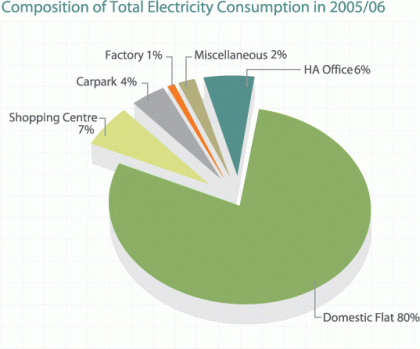
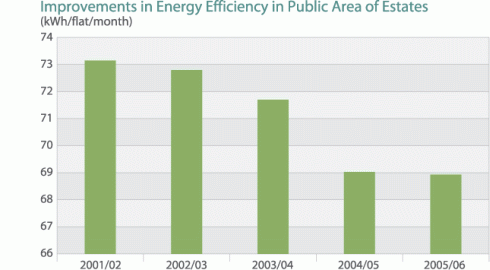
With the support of our staff and energy wardens, electricity consumption at our headquarters building in 2005/06 was 4.06% less than the previous year. Electricity consumption at our headquarters building is now 14.3% less than the baseline year of 2002/03 when we first introduced energy consumption reduction targets.
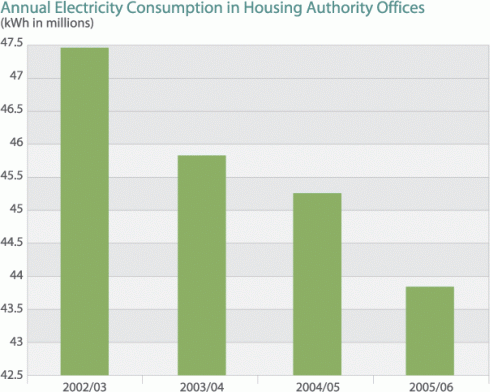
We are constantly seeking new and innovative ways to improve our energy efficiency. In the past year we have sought to gain experience with some alternative energy sources by installing solar panels (photovoltaic systems) for external lighting in three estates. We have communicated with the two electricity providers in Hong Kong on areas such as energy efficiency and cleaner energy. We also completed small scale trials on the use of LED and self-luminous exit signs. Opportunities were identified for energy savings by modifying the design of exit signs. In the past year, we have also been working on the trial adjustment of counterweights in lifts and we are working to measure the potential energy savings. In addition, we have been conducting trial use of nano-reflectors to enhance luminance and therefore reducing energy needed. Trials were completed and are under evaluation.
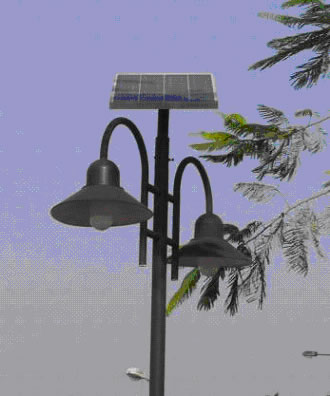
For this year, we continued to commit ourselves to efficient waste management by undertaking the 4Rs: Reduce, Reuse, Recycle and Recover.
| Targets | Our Performance | |
| • | Conduct quarterly survey and develop guideline on selective demolition with an aim to reduce construction waste. | Quarterly surveys on construction waste have been conducted. Construction waste index is being developed. Substantial progress on promulgation of guideline for selection demolition. |
| • | Implement the new waste handling system and thus improve the hygienic and cleanliness in housing estates. | Installation of Central Compactor System/Distributed Compactor System (CCS/DCS) in new development projects. |
| • | Use sustainable timber doors. | Pilot project identified. |
| • | Explore and study application of green design for building services and equipment. | Conducted trial studies. |
| • | Increase domestic waste recovery rate for | |
| › paper (Pa); | Recovered 12.16%, short of the 14% recovery rate target. | |
| › aluminium cans (Ac); | Recovered 19.3%, short of the 23% recovery rate target. | |
| › plastic bottles (Pl); and, | Recovered 3.2%, above the 1.9% recovery rate target. | |
| › used clothes (Uc) | Recovered 526 tonnes used clothes. | |
| • | Reduce domestic waste. | Reduced by 5.1%, above the 1% reduction rate target. |
| • | Promote recovery of spent mercury-containing lamps and bulbs. | Launched the recycling scheme. |
| • | Promote recovery of used rechargeable batteries. | Launched the recycling scheme. |
| • | Implementation of waste separation at source. | 30 estates have joined the scheme to implement source separation of waste. |
| • | Reduce A3 and A4 paper consumption in HD offices. | Reduced by 3.6% against previous year and 8.6% against baseline year of 2002/03. |
| • | Collect waste paper in HD offices. | Collection increased by 1.4% against previous year and 9.1% against baseline year of 2002/03. |
| • | Use environmentally friendly paper in printing of all publicity materials (except sales and marketing publication). | Implemented the use of environmentally friendly paper as pre-requisite in printing jobs. |
In the past year, there were two targets where we fell short. Both the recovery rates for aluminium cans and paper were recorded below targeted levels. We suspect that residents' contribution direct to recyclers might be partly responsible for this and the observed lower recovery rates may also be due to removal of these recyclables from the bins by scavengers before we can collect them.
According to our Waste Reduction Credit Scheme records, residents generated 0.74 kg per person per day in 2005/06 compared to 0.78 kg per person per day in the previous year. This represents a 5% drop in the amount of domestic refuse generated in our estates compared to the previous year.
Waste recovery rates in the past year were at similar levels to previous years with our residents continuing to make significant contributions to environmental protection by using the recycle bins. In total, over 10,140 tonnes paper, 120 tonnes aluminium cans and 190 tonnes plastic bottles were recovered for recycling from our estates in the past year. Meanwhile, we launched a new campaign to collect used rechargeable batteries in all our estates. About 229 kg of batteries were collected. In addition, we continued to support the waste recovery initiative by Friends of the Earth to collect moon-cake tin boxes. In 2005/06, residents brought in 42,681 moon-cake tins for recycling which is 51% more than in the previous year. We have also helped in EPD's Waste Electrical and Electronic Equipment Recycling Day. We provided collection facilities in all 190 of our estates for residents to dispose of unwanted equipment for reuse and recycling.
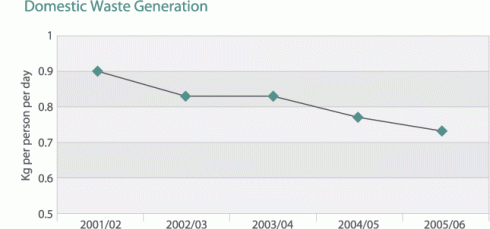
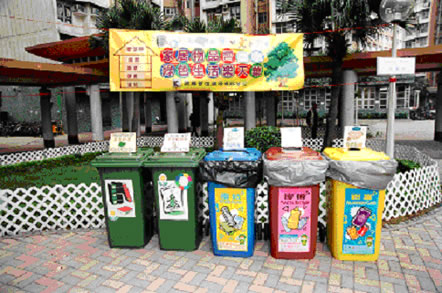
The amount of paper deposited by our staff for recycling in our offices in 2005/06 was 161,348 kg, which is 1.4% more than the previous year (9.1% increase against baseline year of 2002/03). In the same period, our office paper consumption fell 3.6%.
In 2005/06 we also increased efforts to use recycled paper.
We are acutely aware of the need to minimize waste associated with construction and demolition (C&D) works. We have adopted many measures to achieve this including the increased use of precast and prefabricated building elements as well as material recycling and reuse and waste separation of inert and non-inert C&D waste. In the past year, 328,900 tonnes of inert construction and demolition waste was generated on our sites.
We have also made progress with developing a database system for the quarterly monitoring of waste generated by individual projects. In the past year, we have studied the Construction Waste Index of some 30 construction sites. We found our construction sites produce about 30% less C&D waste than similar-sized private development projects based on a study undertaken by the Hong Kong Polytechnic University.
Reduction of paper consumption continued to be implemented through increased use of recycled paper, posting of circulars/memos and publications via the internet and e-mail system and circulation of paper saving tips. These efforts have led to a 3.6% decrease of paper consumption compared to the previous year.
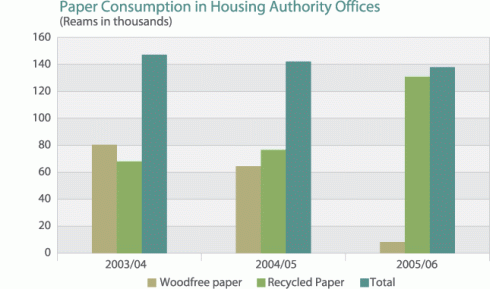
Of the 137,862 reams of office paper used in 2005/06, 94.5% was recycled paper and the remainder was wood-free paper.
Other initiatives to reduce the environmental impact of paper consumption include using recycled paper in the printing of publicity materials.
By increasing the use of recycled materials in our activities (ie construction materials and paper) and collection of waste (ie aluminium cans, etc), we were able to decrease wastage from our activities. Due to these achievements, we were assessed by EPD under the Wastewi$e Scheme as continuing to make 'good achievements'. As a result, the Gold Wastewi$e Logo was retained for the fifth consecutive year.
We have continued our use of pulverized fuel ash (PFA) as a partial cement substitute on our construction sites. In 2005/06, our use of PFA saved 12,730 tonnes of cement use.
In the past year, we have continued to insist our contractors use reusable metal hoardings, metal formwork and prefabricated building elements. As a result, in the past year we were able to avoid the use of 18, 470 tonnes of timber.
In line with our aim of increasing use of timber from sustainably managed forests, in the past year we have commenced a pilot project on the use of timber doors from accredited sustainable sources.
In line with legal requirements for the proper disposal of spent florescent lighting tubes and bulbs, in 2005/06 we sent 192,724 tubes and bulbs for safe disposal. As at 31 March 2006, a total of 365,156 of these mercury-containing tubes and bulbs have been transferred to EPD's Chemical Waste Treatment Centre for safe disposal.
In the past year we safely removed about 82 m3 of asbestos-containing materials during the demolition of Cheung Sha Wan Flatted Factory. This work was a continuation of our ongoing Asbestos Abatement Programme and represents 1% of the asbestos-containing materials identified on our premises in a 2001/02 study.
In 2005/06 our consultants finished a detailed study to examine the potential impacts on the environment from our tenants' activities in our existing flatted factory premises. We are now following up on the recommendations of the study and are implementing measures to better control and manage potential environmental risks associated with these factories.
We continually keep track of our contractors' performance including thorough site inspections. In 2005/06, we have recorded only one environmental non-compliance incident (four in 2004/05 and eight in 2003/04) on one of our contractors for water pollution to a communal drain. This has since been rectified and a penalty imposed in accordance with the contract provisions.
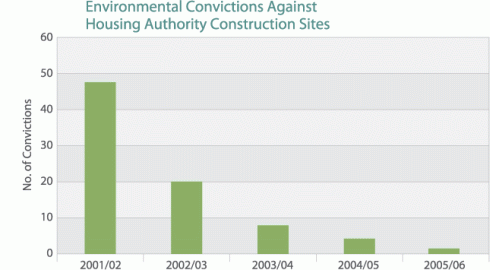
Life Cycle Assessment and Life Cycle Costing of Building Materials and Components
In response to our commitment to minimize the use of natural resources and achieve cost effectiveness in the production and provision of public housing, we commissioned a study on the combined Life Cycle Assessment (LCA) and Life Cycle Costing (LCC) of building materials and components that we use.
The key objectives of the study were to identify any significant environmental impacts associated with the use of materials, and to provide support to the decision-marking process so that purchase of materials with lower environmental impact, if both technically acceptable and cost effective throughout their whole life span, can be facilitated. As such, the purpose of the study was to develop, in Housing Authority's context and from a whole life cycle point of view, an integrated decision support tool to help inform the procurement of environmentally conscious and cost effective alternatives.
As part of this major collaborative effort among Housing Authority, Bussiness Environement Council, Davis Langdon & Seah Management Ltd and Hong Kong University, in 2004/05 we completed the study to understand the environmental and cost performance of our New Harmony Block 1 design over its entire life cycle.
The direct outcomes of the study were:
- an in-house database and technical guidelines of Housing Authority's major building materials, taking into consideration LCA and LCC; and
- a procurement strategy and specifications for more environmentally friendly materials, which are technically and economically viable.
As part of this study, an interactive computer programme has been developed which allows our architects and structural engineers to examine whether environmental and cost benefits can be gained by incorporating alternative materials in the design. As such, this tool can answer questions on whether using alternative materials can improve the environmental sustainability of the design and is an invaluable decision-making tool in our procurement decisions.
A reference 'acceptability line' was developed based on the study. The line marks the corresponding acceptable cost and environmental impacts interactions and is applied for all of the common building materials used by the Housing Authority. As such the Life Cycle Assessment assisted the decision making over the use of certain building materials and components when our staff consider its cost and environmental consequence. Our aim is to ensure that all of the materials we use fall within the acceptability area, whereby environmental impacts are minimized with reasonable cost.
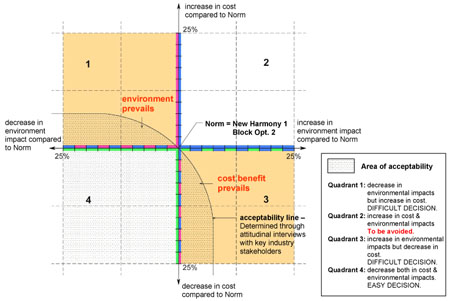
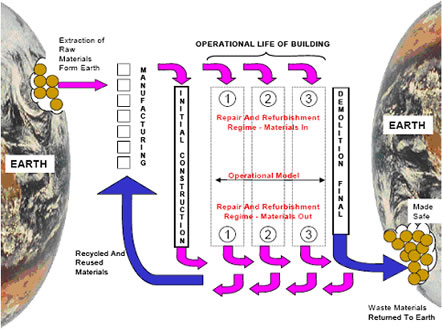
This forms a tool for us to make the best decision both financially and environmentally and therefore makes itself a significant contribution to achieving sustainable building designs.